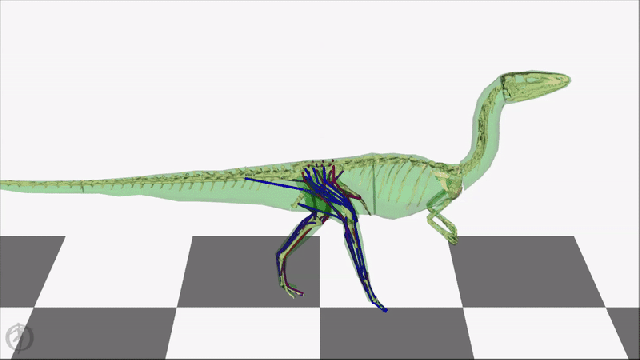New 3D simulations of dinosaur movement suggest that some of the animals may have swung their tails to and fro to help them move, similar to how we humans swing our arms. Looking at the simulated movements of one Triassic theropod, Coelophysis bauri, an interdisciplinary team of researchers suggest that movements of the tail from side to side could have helped some dinosaurs regulate their angular momentum and reduced strain on muscles.
The team grounded their simulation of the dinosaur, which lived around 200 million years ago, in the movement of the elegant crested tinamou, a living South American bird that prefers walking and running to flying. The finding that C. bauri’s body may have moved with a bit less rigidity than previously understood could be expanded to other dinosaurs, helping carve out nuance in how the extinct animals moved. The team’s results were published today in Science Advances.
The finding means “there was also greater diversity in dinosaur movement patterns — that some dinosaurs would have moved differently to others, and we shouldn’t simply pigeonhole all theropods (for example) as moving in the exact same fashion,” said Peter Bishop, an evolutionary biomechanist at Harvard University and lead author of the study, in an email to Gizmodo. Bishop said that “shouldn’t be surprising, given that they were kicking around for >160 million years: they had plenty of time to tinker with how they worked.”

Once they determined that their model for dino locomotion resembled how the tinamou moves in real life, the team applied the model to a musculoskeletal recreation of the dinosaur. They found the speed of the dinosaur was comparable to previous estimates, but its neck and tail moved in lockstep, helping the animal maintain its angular momentum as it ran, in the same way that we humans swing our arms when we run or walk.
“It’s always good to see robust computational biomechanics approaches applied to dinosaur locomotion,” Nizar Ibrahim, a vertebrate paleontologist at the University of Portsmouth who is unaffiliated with the recent research, told Gizmodo in an email. “I think many of us strongly suspected that dinosaur tails were more dynamic and complex than previously assumed, but what we really needed were robust quantitative approaches.”
In 2020, a team led by Ibrahim published their analysis of the well-preserved tail of a spinosaurus, a carnivorous dinosaur known to prowl around waterways. Based on the structure of the tail, Ibrahim’s team posited that it was a swimming dinosaur. Though questions remain about how strong a swimmer spinosaurus was, these sorts of models are helping paleontologists bring fossils to life by articulating the skeleton in three dimensions, slapping on some muscles, and using modern analogues to reveal new best guesses about dinosaur movement.
“Now that we’ve got this simulation framework implemented and the simulations themselves solve very rapidly, it means that we are now primed to explore locomotion and other behaviours in a whole host of other extinct critters, and not just dinosaurs,” Bishop said. “Pretty much anything is fair game. This is the great power of the simulations — that they allow us to explore anatomies that have no modern equivalent, and thereby test questions that are otherwise impossible to answer.”

The swaying would have been different depending on the length and size of the tail, Bishop wrote, and some may have not used the capability for reasons of movement at all. For some dinosaurs, courtship displays could have called for a flicking of the tail, and the structure of ornithopod dinosaur tails would’ve made the appendages stiffer. When Bishop’s team removed the tail in their simulations, the dinosaur had to apply 18% more muscle effort as it moved.
“Like all models, there are areas where reality is much more complex than the simulation. Things like the interaction of the foot with the ground and indeed the control of the non-limb parts of the skeleton are all things we can do better in future,” Bill Sellers, a computational zoologist at the University of Manchester who is unaffiliated with the recent research, told Gizmodo in an email. “The ultimate goal is a digital twin of the fossil ecosystem so we can really understand what these animals did and how they lived.”
The research is the latest work out of a five-year project to understand how early dinosaurs functioned compared to other reptiles of their time. With their upright posture and bipedalism, theropods are a great resource for understanding how different means of locomotion evolved over time.
More: Running Dinosaur Robot Reveals a Possible Way Dinos May Have Evolved Flight
